A
Plan for the Conservation of the Harbor Porpoise
By
Krzysztof Skora & Iwona Kuklik
Translation provided by Aleksandra
Cegielska-Johnso
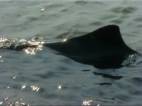
It
is known for its mysterious lifestyle. It has been seen by only few. It is
an endangered species. The harbor porpoise also incorrectly (by scholarly
fashion) called “the dolphin of the Baltic”.Dorsal
fin of harbour porpoise. This body part is most often seen on the water
surface.
In
1991, the Agreement on the Conservation of Small Cetaceans of the Baltic and
North Seas (ASCOBANS) was ratified by its first co-signatories. Poland
became a member of this alliance in 1995. Since then, the University of
Gdansk Marine Station located in Hel has been conducting research on the
biology and ecology of animals inhabiting the Polish zone of the Baltic Sea.
A considerable amount of research data has been collected leading to the
issuance of several research papers and popular articles. An educational
campaign targeting the conservation of these animals was also developed. All
of these factors have greatly contributed to better understanding the
condition of these mammals in Polish waters.
Despite
the legal protection for this species, not only limited to Poland, each
successive international conference or gathering of experts consistently
reaches the same conclusion that the population of the harbor porpoise
continues to perish in the Baltic Sea. The other unanimously agreed upon
conclusion is that the rate of its extinction is so fast that the survival
of this species is not ensured. The past two years appear to have brought
significant attempts to reverse these dangerous tendencies. Several new
research projects were started and the experts have drafted future meetings
and educational efforts.
An
interesting meeting took place in December of 2001 in Brussels. The
distinguished panel of experts was debating the issue of the unintended
catch of small cetaceans due to their accidental entangling in fishing nets
in waters controlled by European Union. The goal of this debate was to
establish the manner for significantly limiting the accidental catch. This
group of experts comprised of representatives from the European Union
member’s countries including a partaker from Poland. The major debates
during the meeting concentrated on the present condition of the harbor
porpoise in the Baltic Sea and the effect of modern fishing techniques on
its population.
An
increasing number of institutions are willing to work in support of the
preservation of the harbor porpoise population. It is not an easy task to
achieve, but every supporting effort will make it more attainable providing
that the entire resolution is not delayed. The Environment Preservation Bank
in Poland undertook the strain to raise funds to support the program for the
research and rescue of these animals. On December 3, 2001 in the old-town
city hall in Gdansk, Bank officials contributed the sum of nearly 18
thousands zloty to the Marine Station in Hel.
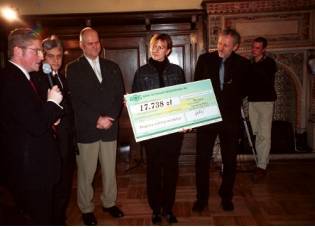
Bank
Ochrony Srodowiska (Environment Protection Bank)
handing
cheque for porpoise protection.
An
international workshop tending towards the development of a plan for the
preservation of the harbor porpoise population in the Baltic took place from
January 9-11 of 2002 in Jastarnia. The workshop was set up through the
combined efforts of the Marine Station in Hel and the Foundation for the
Development of the University of Gdansk under the auspices of ASCOBANS and
with financial support of the Danish Cooperation for Environment in Eastern
Europe (DANCEE). The workshop was to some extent unusual since the partakers
from all Baltic countries representing numerous marine and environmental
protection administrations, fishing and scientific communities, as well as
public organizations were actively participating. The means of limiting the
death of these animals were under discussion. The extent of the endangerment
for the Baltic population of the harbor porpoise, the complexity of research
regarding their biology, ecology, migration, and methods of quantity
assessment were all of prime concern of the opening lectures.
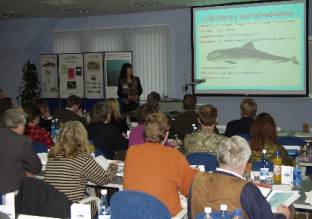
Lecture
on harbour porpoise biology by dr Christina Lockyer
All
of the participants were seriously alarmed by the imminent lack of time
remaining to undertake actions to effectively protect the harbor porpoise.
The present death rate of the harbor porpoise is 3 times higher than its
reproduction ability. If this undesirable ratio will prevail for
approximately 30 years, then the Baltic population of the harbor porpoise
will perish.
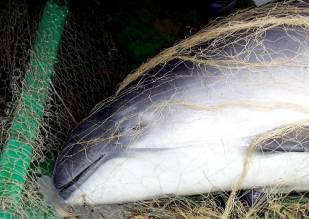
Porpoise
in a net
|
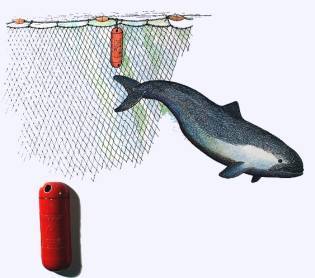
Pinger – porpoise deterrent
|
In
September of 2001, the crew of the yacht “Song of the Whale” was
observing and monitoring the population of harbor porpoise in the Polish
zone of the Baltic Sea. As a result, they were able to spot only two
specimens of harbor porpoise; the first one in the proximity of the Wolin
National Park, and the second one several miles to the north. The observed
number is viewed as extremely low. Many more specimens of harbor porpoise
were spotted in the vicinity of the island of Rugen, particularly to the
west of the island. Any information regarding the manifestation of the
harbor porpoise in the Polish zone of the Baltic beyond September is not
available.
All
of our interlocutors indicated that the harbor porpoise is continually
imperiled by modern fishing nets and that the present designs of the nets do
not ensure the survival of these marine mammals. The very delicate materials
used to construct the nets prevent them from being registered by the harbor
porpoise’s hydro-location system. The reverberated signal is too weak to
be sensed by animals. The ways to avoid this problem remain to be determined.
The
United States and Canada are successfully using acoustic scaring devices
called “pingers”.
In
areas with the highest occurrence of accidentally catching the harbor
porpoise, these devices were installed on the fishing nets. This simple
undertaking largely reduced the number of harbor porpoise perishing in these
areas. The same system is currently being tested along the coast lines of
Denmark and Sweden. Whether this system will be adopted in the future along
the entire coast of the Baltic Sea still remains unknown. Many western
European countries do, however, attach great importance to this deterrent.
Representatives
of the fishing communities participating in the Jastarnia meeting supported
without any reservations the call for the preservation of the harbor
porpoise. However, concern over who will be burdened with the related costs
greatly troubled them. Their
anxiety arose from the fear that the fishing communities will bear all the
costs related to the modernization of the fishing equipment. Several options
of financing similar ventures were debated during the meeting, and several
different solutions to the problem were considered. Many countries already
co-finance various pro-ecological investments; therefore, the co-financing
of nature friendly fishing tools seems only logical. Farmers do receive
compensation for game caused damage; should not fishermen be treated alike
in regard to the financial damage they are facing?
Financial
resources based outside the government are also available to support
projects aiming at the preservation of various scopes of nature. A number of
tasks to protect nature and to restore its native state are currently being
undertaken. Several endangered species like wolf, lynx, eagle, bison, and
bear are presently under protection. In order to save the perishing species
of fish like salmon and bull-trout, their natural habitats are being
re-created and stocked. The new areas are planted with trees to assure
future forests. The most precious fragments of existing afforested regions
are preserved and their most magnificent specimens are included within the
definition of the protective law. In the view of all these undertakings, it
only seems fair to introduce the same degree of preservation and financial
protection in relation to the nature of the sea. In fact, in order to do
just that we should first observe the same measures towards the sea-nature,
as we already observe towards the land-nature.
The
other measure one can use to ensure that the harbor porpoise can recognize
the presence of the nets set in the water is to change the very construction
of the net. The means to achieve this are quite simple. The materials used
to produce floats and ropes for fishing nets should better deflect the sound
sent under water by the harbor porpoise as well as generate more noise as
compared with the materials presently used.
Scientists
researching this problem recommend improving fishing nets by using plaited
cords which are able to deflect sounds and/or using floats which are filled
with air. These upgraded nets work like the original ones, but now they can
be recognized by small cetaceans such as harbor porpoises and dolphins from
a safe distance.
The
other way to ensure the survival of small cetaceans is to initiate changes
in fishing techniques. It is self-evident that employment of certain
specific types of fishing nets or fishing techniques is significantly safer
for animals as compared with others. There are numerous examples from around
the world that the fishing industry was successfully forced by demands of
the market to modify and/or improve their fishing techniques in order to
protect dolphins. Fish relishing consumers demanded a guarantee that their
consumption, of for instance tuna, is not attended by the death of dolphins
as a consequence. Fish products associated with environmentally friendly
fishing techniques were marked with specific certificates of origin or other
labels. This way the sensible fish consumers were able to affect the saving
of thousands of dolphins. If this approach will find its advocates across
Europe remains to be seen. In order to help the fishing community operating
on the Baltic Sea to promptly modify their fishing strategy and modernize
fishing equipment, we ought to closely observe the state of affairs on the
North Sea. In a matter of a few years, the European Union will have control
over the major part of the Baltic Sea.
Therefore,
the unification of laws and regulations defining the utilization of Baltic
resources is inevitable. The urgent call for preservation of the Baltic
population of harbor porpoise necessitates the rigorous control over
environmental pollution. Pollution control is, however, expensive. Obsolete
production technologies ought to be replaced with modern and environmentally
friendly technologies. The toxic substances presently polluting the Baltic
waters are without a doubt affecting the well being of the harbor porpoise
population. It has been already shown that seals are negatively affected by
the pollutants. Similar susceptibility including the pathological
modifications of the female reproductive organs of the harbor porpoise can
not by be excluded. Due to these pathological modifications, chances for
pregnancy of these mammals are slim. These types of modifications also
preclude prompt delivery and do not ensure healthy breed. How the current
levels of DTT, PCB or heavy metals presently found in the Baltic can be
reduced and whether it can be done promptly enough remains to be seen. It is
obvious that the program regarding the construction of new water treatment
plants is not sufficient.
The
question debated during the meeting in Jastarnia was whether any particular
region of the Baltic Sea should be designed for a refuge for the harbor
porpoise. Some observations point to the German zone of the Baltic located
to the west of the island of Rugen as a candidate for such a refuge. However,
considering the present state of the harbor porpoise population it seems
reasonable that the entire Baltic Sea should be recognized as a refuge.
During
the meeting in Jastarnia, one of the workshop groups entirely devoted its
time to debating future educational efforts supporting the program of
protecting animals. They
elaborated on numerous ideas for informing and guiding campaigns addressed
to the residents of the Baltic countries. They also pointed at fishing,
sailing and tourism communities as well as administrative communities
responsible for the coastal natural resources as professional groups which
in their view should be the primary recipients of the developing information
about biology, ecology and condition of Baltic harbor porpoise.
The
harbor porpoise is very scattered and it exhibits an incredibly secret
lifestyle; therefore, these days it is rarely visible to the human eye.
Since it only briefly and unforeseeably emerges from the water to catch its
breath, it practically remains unperceivable. Evidently, convincing people
about the immediate need for protection of something they can not see is not
easy. In Denmark a special establishment was created where living harbor
porpoise are kept and exhibited to the people. Other countries produce
documentaries or organize excursions, all in order to introduce the harbor
porpoise to the general public. Although similar undertakings are hard to
execute in the Polish zone of the Baltic, none the less it will be difficult
to escape the responsibility for lack of educational efforts presenting
harbor porpoise and its fate to the public.
In
1995, the Agreement on the Conservation of Small Cetaceans of the Baltic and
North Seas (ASCOBANS) was ratified by Poland. Since then Poland is under
international obligation to provide educational efforts in support of the
conservation of the harbor porpoise. In order to mobilize public efforts to
protect harbor porpoise, participants of the meeting in Jastarnia stipulated
for creation of a “Harbor porpoise Day” to be observed annually on the
third Saturday of May in all countries where the harbor porpoise is
recognized as an endangered species.
Legal
instruments protecting the harbor porpoise are already in place. The
recognition of the harbor porpoise’s present condition is established.
Only the manners of how to assure the survival of the harbor porpoise have
yet to be determined. Normally, it is the scientific community which is
expected to offer solutions, preferably simple and evading all conflicts.
However, contrary to all expectations the solutions lies in the hands of the
people exploiting the sea and those who manage its natural resources.
The need for debate on all of these issues stimulated and encouraged
organizers to set up the meeting in Jastarnia. It provided an unfamiliar
platform in Poland for the collective evaluation of the condition of the
surrounding nature. However, to be persuaded by the authority of the tribune
does not assure that the general public will accept all of the presented
facts. It is also difficult to convince the public to apply, not easy, but
potent and effective protective efforts as opposed to easier but ostensible
ones.
There is no one within
the fishing community who would not be deeply saddened by seeing a harbor
porpoise accidentally caught in the fishing nets. Each such misfortune is
accompanied by a sense of sorrow and helplessness. After all, the harbor
porpoise as a fish-hunter is perceived as a fellow in the same trade. All
fishermen wish for these likable animals is to accompany them and their
boats on the sea. The Jastarnia Plan offers the first step in the right
direction.
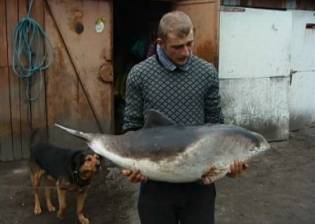
Fisherman
with a porpoise
Krzysztof
Skóra & Iwona Kuklik
Hel
Marine Station, Poland
|






